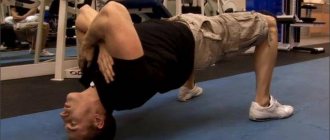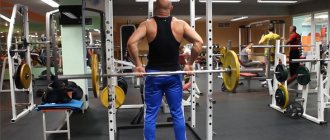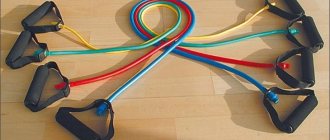Share:
Shoulder and arm rotations are a necessary warm-up exercise before any strength training or morning exercise. They prepare joints and ligaments well for stress. Most training injuries are due to lack of warm-up.
Do not forget that in addition to the joints, you also need to prepare the muscles for work - for this, warm-up approaches are performed with light weights.
Do you like to swing, love and warm up?
It doesn’t matter who you are – a losing weight girl, a broad-shouldered athlete or a skinny teenager, just as it doesn’t matter what you do – light fitness or professional powerlifting. To everyone/everyone who is at least somehow involved in sports (except perhaps for chess and poker players
) it is necessary to prepare your muscles and joints for sports loads.
Moreover, you need to not only warm up, but also cool down. It's written here about the post-workout cool-down, let me remind you today we're chatting about pre-workout warm-up exercises.
It is worth immediately noting that before doing warm-up exercises, you need to spend a few minutes warming up your muscles and ligaments. But more on that later too.
How to warm up before a workout
Now, carefully so that they are called in order, I will present all the exercises on which the warm-up before a bodybuilding workout will be based. For the first time I decided to photograph myself as an example. It's crazy how much work this gave me while I processed the pictures. Please leave feedback in the comments on whether or not you should bother with such crap in the future.
At each individual training session, it would be necessary to carry out the entire list below with one small clarification: we warm up those joints that will work during a specific training a little longer than those that will not be involved.
In general, in order to warm up well before training, it is enough to dedicate some 5-10 minutes of your precious training time to warming up.
Exercises to warm up the neck
Although our neck is rarely involved, it also needs to be warmed up at every workout!
Turns the head left and right
Keep your head level, your chin almost parallel to the floor. We turn our heads left and right.
The exercise is done without very sharp jerks, 5–10 times in each direction.
Amplitude nodding of the head
At the starting point, the head is level, the cervical spine and the spinal spine form a straight line. As you inhale, lower your head down and pull your chin toward your chest. As you exhale, raise your head and tilt it back. The exercise is also done slowly, 5-10 times in both directions of movement.
Head rotation
After the above exercises, it’s time to turn your head clockwise and counterclockwise. 6 times in each direction will be enough.
Exercises to warm up the shoulders (deltoids)
Shoulder rotations
This exercise is somewhat similar to breaststroke swimming, only standing and without water.
. In a standing position, we wave our arms bent at the elbow joint. The bending angle can be either slight (160°-140° degrees) or reach 90°, or even less. In fact, for the range of motion in the shoulder joint, the angle of elbow flexion does not matter much, it’s just that when the angle is smaller it is more convenient to do so (you will occupy less area).
We wave both hands first forward 5-10 times, then back the same amount.
Shrug
Let’s imagine that they asked you the time, but you don’t know and for some reason you can’t say it in words (either your speech took away, or your brains
). And you start shrugging your shoulders like in the picture.
To enhance the warm-up exercise, you can rotate your shoulders back and forth, this will not hurt.
Swings with body rotation
In the starting position, the hands and elbows are approximately on the same horizontal line at chest level. The back is straight, the chest is in a wheel, the hands are pressed to the chest.
With a fairly sharp movement, we move the arms bent at the elbow back so as to bring the shoulder blades as close to each other as possible. The next movement will be to rotate the body above the waist, simultaneously with straightening the arms at the elbow joint and, as a result, bringing the shoulder blades closer together.
Next we return to the starting position.
It seems easier to show than to describe:
LitLife
Andrey Bokatov
Sergey Sergeev
CHILDREN'S YOGA
Introduction
Dear reader!
The book you are holding in your hands is unique in its own way. In it, perhaps, for the first time, the methodology for using the most ancient science in the world - yoga - for the harmonious upbringing of children, understood as the development and improvement of not only the physical body, but also the soul and spirit, is outlined.
We hope that this book will be useful to parents who want to raise their children to be natural and free individuals, and to preschool teachers, school teachers, and professional yoga instructors teaching in children's groups.
This book is primarily a practical guide. The book contains a huge number of practical techniques tested in kindergartens, schools and yoga groups in the cities of Kharkov, Zaporozhye, Dnepropetrovsk, Minsk, Nesvezh, Rostov-on-Don, Samara, etc.
Part 1, chapters 2.1–2.3, 2.5–2.7, 3.1–3.12, 3.30–3.32, 4.1–4.12, 4.21–4.22 prepared by S. Sergeev.
Parts 5, 6, chapters 2.4, 2.8–2.10, 3.13–3.30, 4.13–4.20 prepared by A. Bokatov.
We express our gratitude and appreciation to everyone who in one way or another helped in the writing of this book and its publication.
Good luck to you in fulfilling the difficult but noble task of raising a new generation!
Part one
Harmonious development of the child
1.1. Harmonious development of a child - what is it?
After all, all adults were children at first, but few of them remember this.
Antoine de Saint-Exupery
"The Little Prince"
The great philosopher, who, according to the Strugatsky brothers, was “unlucky with admirers,” Friedrich Nietzsche wrote: “Man is a rope stretched between an animal and a superman.” Most sages, despite differences in the teachings they preach, agree that man is not at all the top of the evolutionary ladder. Man is one of the steps of this ladder, and far from the last. Perhaps we “stayed a little late” at this stage (although the time of “conscious development” of humanity on the scale of the Universe is insignificant). But if our soul passed through the steps of the same evolutionary ladder to man to some extent unconsciously and individual perfection in this case meant little, then the transition from the “human stage” to the next is possible only through the conscious work of each individual on himself.
For adults reading these lines, it is already extremely difficult (although not impossible) to consciously evolve to the next stage, and most likely this is already the prerogative of future lives. However, you can help your children become a harmoniously developed personality, because only that person whose body, soul and spirit are developed to approximately the same extent at a high level will be able to move to the next step of the evolutionary ladder.
So, the harmonious development of a child includes the development of body, soul and spirit.
Body development - physical development, a strong and resilient body, excellent health, and therefore the ability to perceive various energy flows (and remain healthy).
Development of the soul - sensory and emotional experience, mastery of the arts, perception of art (communication with Beauty).
Development of the spirit - knowledge of the world and oneself.
All these three components are in fact closely interrelated and complement each other. Development only in one of these areas without the development of others is possible only to a certain level. Therefore, if you nevertheless decide to help (namely help, in this case it is impossible to force) your child to develop harmoniously, then it is advisable from the very beginning of upbringing to pay attention to ensuring that there is no excessive development of any of the components to the detriment of others.
And here the most ancient science in the world can come to the aid of adults - yoga, which, with a competent approach, gives harmonious development and promotes the development of not only the body (as is often believed), but also the soul and spirit.
1.2. When to start education
It has already been proven that early childhood, infancy, is decisive for the formation of an individual’s intellectual abilities. It is already too late to deal with the development of a child at three to five years old; this is no longer the beginning, but the middle of intellectual development.
In Philadelphia (USA), the Institute for the Study of Human Potential concluded that the “correct age” at which a child should be taught to read is one and a half to two years, and in Japan a school for gifted children has been created, which accepts four-year-old children.
Scientists note (according to Professor Blum) that a child acquires 20% of future intelligence by the end of the first year, 50% by the age of four, 80% by the age of nine, and 92% is developed before the age of 13.
The following example speaks to the importance of education from a very early age: the girl spent only six months with the wolves - from a year to a year and a half. Then she lived with the researchers for 48 years and during this time she learned only a few dozen words, in addition, every night she went into the kitchen and howled. Apparently, wolf “upbringing” took precedence over human heredity. Moreover, there are not so few such facts when children were found “raised” by animals (from the times of Ancient Rome until 1940, more than 30 cases were registered in different countries when children were fed by animals). In almost all cases, while living with animals, the mental development of these children stopped. They developed physically, but not mentally. All the “Mowgli” found died before reaching old age, without ever becoming human.
To the question of when it is necessary to start raising a child, there are many answers in the literature. Most of them boil down to the fact that the upbringing process begins from the moment the child is born. However, in our opinion, it is even better if parents begin raising a child from the moment they learn that a woman is pregnant (by the way, among some peoples, in particular among the Mongols, the beginning of life was counted not from the moment of birth, but from the beginning intrauterine development).
1.3. Parenting before birth
Recently, you can increasingly hear about raising a child even before his birth. However, many nations have practiced such education for a long time or have practiced it before.
For example, among the Lao (Laos) peoples, raising a child begins when the fetus is in the mother’s womb, and she must constantly remember this. A woman’s good health during pregnancy indicates that the unborn child will have a long life, and on the contrary, various ailments and disturbing dreams portend dangers in his life. During pregnancy, a woman should refrain from certain activities that could harm the unborn child. For example, it is forbidden to eat bee larvae (the child will be restless, like a bee); a woman’s desire to pay too much attention to her hair and clothes is condemned (the child will grow up proud); it is not advisable to sit on the bottom step of the stairs (childbirth may be delayed), etc. (sympathetic magic - like attracts like). These Lao beliefs seem somewhat naive to us, but many of these actions make sense, because the mother is in an inextricable connection with the unborn child and everything she does, feels, thinks is reflected in one way or another on the child.
Also, among the Lao, a pregnant woman is instructed to strike herself on the lower back three times with clenched fists every morning, repeating: “Let the placenta fall, let the membrane covering the child be removed.” In the evenings, after washing the body, it is recommended to massage the stomach and run the tails of the eels along it so that the child, like an eel, can easily come out into the world. Again, despite the apparent naivety, this is not only a massage, but also an excellent way of self-hypnosis.
Exercises to warm up your chest and back
Self hugs
In the starting position, your back is straight, your arms are extended at your sides, your chest is in a wheel, your gaze is straight ahead.
We hug ourselves by the shoulders, so tightly, as if we love them very much, trying to reach over our shoulders with our palms to our shoulder blades. With the right hand to the left shoulder blade, and accordingly with the left hand to the right shoulder blade.
While bringing your arms together, we draw in your chest and round your back.
It turns out that while performing this exercise, one hand at the top point is always somehow higher than the other. And it turns out that at each repetition we change the order of hands.
Damn, I explained it in such a way that I wouldn’t have understood anything myself. Well, nothing, for clarification there is an infographic:
Rotations of the body above the waist
We clasp our hands at chest level and turn our body to the right and then to the left. The legs are pressed to the floor and motionless. The movement seems to come from the lower back.
Sipping
We clasp our hands together in front of us and twist (twist) our wrists.
At the lowest point of the exercise, the hands are at groin level.
With our hands straight at the elbow joint, we raise our “lock” above our heads with the maximum range of motion for this.
Stretch with arms behind
We clasp our hands behind our backs and stretch our hands up.
This exercise, unlike the previous one, is not convenient; the amplitude of movement slightly contradicts our physiology.
Therefore, this exercise has a very, very modest amplitude, and in order to increase it even a little, we need to increase it; we need to perform a slight forward bend at the top point of the movement.
Standing Dumbbell Raise
This is an isolated exercise that works the biceps. To perform it, follow these instructions:
- Take the starting position - standing, back straight. Lower your arms with dumbbells along your body;
- Smoothly bend your elbows, bringing your hands with dumbbells as close to your shoulder as possible, turning them with your palms facing you. In this case, the elbow should be pressed to the body and not be separated from it during the exercise;
- Next, also smoothly extend your arm, but do not straighten your elbow completely.
Repeat the movement 12-15 times, then take a break for 1-1.5 minutes (depending on how tired you are), and repeat the exercise two more times. Note that you can bend both arms at the same time or alternately. In the second option, it will be easier for you to control the correct movement of each hand.
You can also make the exercise more difficult. To do this, during bending, simply do not turn the hand with your palm facing you. Thus, the anterior bundle of the deltoid muscle (the very edge of the shoulder) will be included in the movement.
Exercises to warm up your arms
Rotation with brushes
Rotate your hands in the wrist area both clockwise and counterclockwise. 10-15 times in each direction.
Elbow rotation
The same as in the previous exercise, only the movement of the hands moves to the elbow joint. This exercise is performed quite sharply.
Elbow extension behind the head
In the starting position, your hands are clasped behind your head, your elbows are bent at an angle of 90° and pressed to your ears. Without changing any other position except bending the elbows, we sharply and often extend our arms at the elbow joint. 5 times within one workout will be more than enough.
Exercises to warm up the lower back
Circular rotations of the pelvis
Feet stand firmly on the floor with the entire sole, hands on hips. Rotate your lower back both clockwise and counterclockwise. We try to keep the knees and shoulders motionless, and the movement is carried out exclusively by the lower back.
Tilts forward and back
With straight arms and legs, we bend down so that our fingertips touch the floor without bending our knee joints. Strictly speaking, this exercise can safely be called a stretching exercise, although it is irreplaceable as an exercise for warming up the lower back.
At the bottom point, when the fingers touch the floor (and if you have a good stretch, you can put your palm on the floor), we freeze a little, after which we return to the starting position. Repeat 2-5 times.
Immediately after the above exercise, place your palms on the back of your lower back and bend as far back as possible (be careful not to fall
). 3-5 bends back are quite enough.
Tilts right left
One hand is rested at the side, the other is slightly bent at the elbow and pointed upward. We lean first in one direction, then in the other. 5 times in each direction.
Bend the torso forward
This exercise is great for preparing your back to handle stress. This exercise improves the flexibility of the spine and loosens the hip joints. The movement involves not only the back muscles, but also the abdominal muscles and gluteal muscles.
When starting to bend your torso forward, place your feet shoulder-width apart. The back is held in position according to its natural curves. Slightly open the chest. Tighten the abdominal muscles, and then move the body forward. During movement, the back is kept straight, twisting at the hip joints. They try to touch the floor with their palms.
At the bottom point they linger for a couple of seconds. Due to the tension of the gluteal muscles, they move to the starting position. Perform a series of such bends for the back.
Leg exercises
Squats
We cross our arms at the back of the head, legs at shoulder level, heels under the ass and butt.
Squatting to the point where our thighs are parallel to the floor.
As in the case of squats with a barbell, special attention should be paid to the lumbar region: the lower back should be slightly arched in the correct execution of the exercise.
Lunges
In the starting position, we stand on the floor, hands on the lower back, feet shoulder-width apart. We take one leg back, place the toes of the back leg on the floor and perform a lunge. The angle in both knee joints at the lowest point should be 90°, and the knee of the leg laid back should not touch the floor. The load at the bottom point is shifted to the front leg. We perform 5-10 repetitions for each leg.
Circular rotations with closed knees
The legs are pressed against each other, the hands are resting with the palms on the knees. Without changing the position of any other joints, we rotate our knees either clockwise or counterclockwise. 10-15 times in each direction.
Walking in place
We march as if some angry ensign is standing next to us, who is ready to throw a training grenade at us if we stop for a moment
. Raise your knees high, above the lumbar line
Well, that’s all, today I looked at the most relevant warm-up exercises in bodybuilding. I apologize if I’m a little delayed, this is due to a great desire to fully disclose the topic.
Happy training to you!
With best wishes, Vitakha Okhrimenko!
Warm-up before running: 20 exercises
During your warm-up, it's important to warm up your entire body to raise your temperature, get your blood flowing, and prepare it for your workout. Perform exercises at a moderate pace to gradually adjust the body to the load.
In our selection you will find 20 exercises that will help you warm up before running. The indicated number of repetitions is calculated for approximately a 10-minute warm-up.
See also:
- Top 20 exercises to warm up before training for 5-10 minutes
- Warm-up before training: what is it for and how to do it
Head tilts to the sides
We start our classes by warming up the neck. During the exercise, keep your back straight and place your hands on your waist. Perform head tilts to each side and forward with full amplitude, but at a slow pace. Start by bending forward, then to the sides.
How much to do: 5 reps each way
Shoulder rotation
In the initial position, the legs are shoulder-width apart, the back is straight, the chin is raised, and the arms are freely lowered down. Rotate your shoulder joints back and forth at an energetic pace, but without sudden movements. Rotate in one direction and the other.
How much to do: 10 clockwise rotations and 10 counterclockwise rotations
Circular rotations with hands
When warming up for running and cardio, it is important to pay attention to the shoulder joints, which are actively involved in training. To warm up your shoulders, move your arms back and rotate your arms in the following pattern: back-to-side-up-forward. Avoid sudden movements, but work with maximum amplitude.
How much to do: 10 clockwise rotations and 10 counterclockwise rotations
Side bends
From a standing position, bend to each side. Keep your hands at your waist and lift your opposite arm as you bend to increase the range of motion and better warm up your joints. Move in one plane - do not lean your body forward or backward.
How much to do: 10 bends in each direction
Mill (tilts towards the feet)
Stand straight, feet slightly wider than shoulder-width apart, arms extended to the sides. From this position, bend toward the floor diagonally. When performing the exercise, do not change the position of your arms and make sure that your back is straight.
How much to do: 10 bends in each direction
Arching your back
Bend your knees slightly and rest your hands on them. In the starting position, keep your back straight. As you inhale, bend your back; as you exhale, arch your back, rounding your spine. The movements are similar to the yoga cat pose, but are performed at a vigorous pace. This simple exercise will perfectly prepare your back and spine for cardio training.
How long to do: 10 reps
Bends to the knees in plie
Get into the starting position for plie squats: feet wider than shoulder width, toes pointed out to the sides, knees bent at right angles. Keep your back straight and place your palms on your knees. Bend your torso toward each knee as far as you can to give your entire body a good warm-up before running or other intense workout.
How much to do: 10 bends in each direction
Squats with arm raises
Place your feet slightly wider than your shoulders and raise your arms straight up - this is the starting position. Then squat using the classic technique, lowering your arms as you move down and raising them up as you straighten your body. At the top point, straighten up completely - your back should be straight.
How long to do: 10 reps
Side lunges
Place your feet wider than your shoulders, fold your arms at your chest. Bend one leg at the knee until it is parallel to the floor, moving your pelvis back. At the same time, the other leg is fully straightened. Return to the starting position and repeat on the other side. Perform this running warm-up exercise with each leg alternately.
How much to do: 5 lunges in each direction
Back Lunges with Arm Raises
Stand straight, arms down. Lunge back while raising your arms up. Return to the starting position with your arms down. Repeat for the other leg. During lunges, the knee of the front leg should not cross the toe.
How much to do: 5 lunges in each direction
Pelvic rotation
Place your feet slightly wider than your shoulders and place your hands on your waist. Perform circular movements with your pelvis with maximum amplitude, moving it far back, to the sides, and forward. This is one of the most important warm-up exercises for running, as it allows you to work your hip joints well, preventing possible injuries.
How much to do: 10 clockwise rotations and 10 counterclockwise rotations
Leg rotation
Stand straight, place your hands on your waist. Rotate your hip clockwise and counterclockwise, stretching your hip joints. This simple exercise should definitely be included in every warm-up before running, cardio or any workout that actively involves the legs. Don't forget to repeat on both legs.
How much to do: 5 clockwise and 5 counterclockwise rotations on each leg
Rotate your knees in a circle
Place your feet together, bend your knees and place your palms on them. Rotate your knees clockwise and counterclockwise, stretching your knee joints. This effective warm-up exercise before running or cardio helps prevent knee injuries.
How much to do: 5 clockwise rotations and 5 counterclockwise rotations
Foot rotation
Stand straight, feet shoulder-width apart, hands on your waist. Bend your knee, lifting your foot. Perform rotations at the ankle joint clockwise and counterclockwise. Repeat with the other leg. Keep the pace slow and do not make sudden movements to avoid injuring your ankle.
How much to do: 5 clockwise and 5 counterclockwise rotations on each leg
Swing your legs back and forth
Stand next to any support (it can be a wall, a tree, a chair), holding onto it with your hand. With the opposite leg, swing forward and backward, moving energetically with maximum amplitude. Keep your back straight, and try to straighten your legs at the knees while swinging. Don't forget to switch sides.
How much to do: 10 swings on each leg
Swing your legs right and left
Stay close to the support. Perform energetic swings to the side, lifting your leg as high as possible and at the lowest point, moving it inward, in front of your supporting leg. The leg moves along the arc path with full amplitude. Repeat for the other side.
How much to do: 10 swings on each leg
Ripple with tilt
Place your feet slightly wider than your shoulders and perform pulsating bends to the foot, to the center and to the other foot. Do not round your back, try to reach the floor with each pulsation. Perform forward bends with pulsation as a warm-up before running to thoroughly warm up the joints of the pelvis and legs.
How much to do: 7 inclines
Raising your knees to your chest
From a standing position, lift your leg bent at the knee, trying to pull it towards your chest. Help yourself with your hands; it is permissible to take a short pause at the top point. Lift each leg one at a time at a brisk pace for a good warm-up before running or cardio.
How much to do: 5 lifts on each leg
Arm extension with leg adduction
The last two exercises in your warm-up will help raise your heart rate and prepare your body for cardio. To perform the first exercise, you need to quickly spread your arms to the sides and close your palms above your head. At the same time as you spread your arms, take a small step forward with one leg, touching your toe to the floor. This exercise is a great stretch for the entire body, including the hamstrings.
How much to do: 20 arm raises
Jumping with arms and legs raised
Stand up straight, arms straight down. Perform jumps, alternately spreading your legs and arms to the sides, and then returning to the starting position. Move quickly and energetically, warming up the muscles and joints of the body well.
How many to perform: 25 jumps











